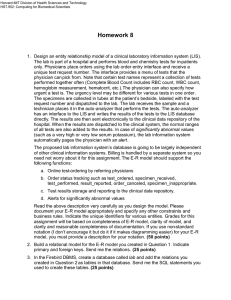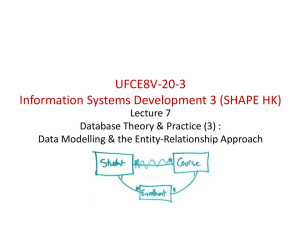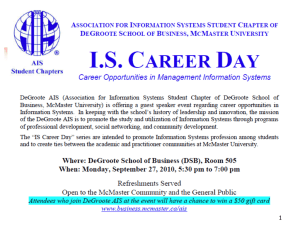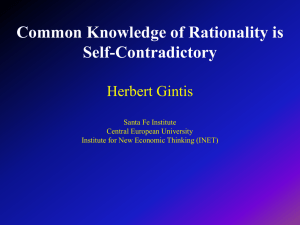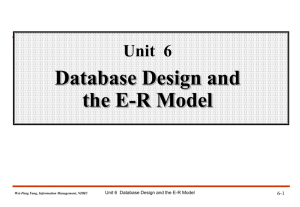8-4 Finite-Expiration American Put
advertisement
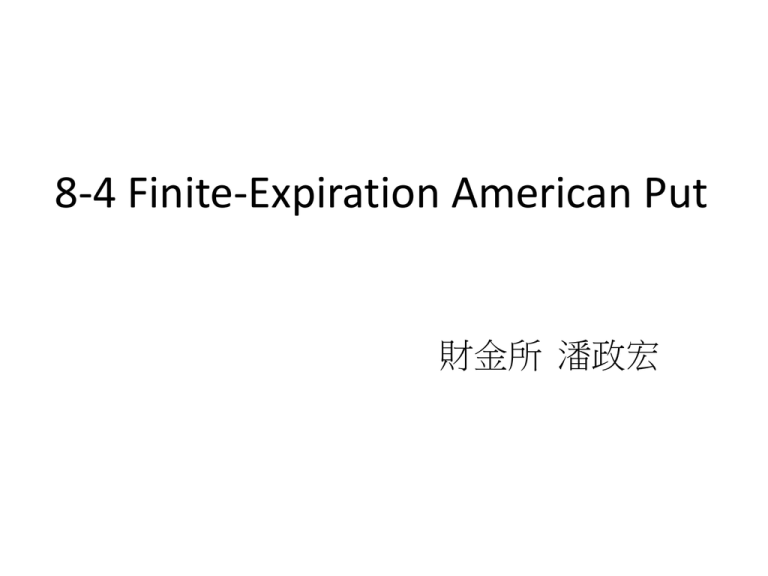
8-4 Finite-Expiration American Put
財金所 潘政宏
Consider an American put on a stock whose
price is the geometric Brownian motion:
dS(t) rS(t)dt S(t)dW(t)
(8.3.1)
But now the put has a finite expiration time T.
Definition 8.4.1
Let 0 t T and x 0 be given. Assume S(x) x. Let F , t u T,
(t )
u
denote the - algebra generated by the process S( ) as range over
[t, u], and let denote the set of the sopping time for the filtration
t ,T
F , t u T taking values in [t, T] or taking the value . In other
(t )
u
words, { u} F for every u [t, T]; a stopping time in makes
(t )
u
t ,T
the decision t o stop at a time u [t, T] based only on the path of the
stock price between ti mes t and u. The price at time t of the American
put expiring at time T is defined to be
~
v(t, x) max
E[e (K - S( )) | S(t) x] (8.4.1)
- r( - t)
t ,T
In the event that , we interpret e (K - S( )) to be zero.
-r
This is the case when the put expires unexercise d.
8.4.1 Analytical Characterization of
the Put Price
The finite-expiration American put price function
v(t,x) satisfies the linear complementarity
conditions :
v(t,x) (K-x) for all t [0,T], x 0
(8.4.2)
1 2 2
rv(t,x)-v t (t , x) rxvx (t , x) x vxx (t , x) 0
2
for all t [0,T), x 0, and (8.4.3)
for each t [0,T) and x 0, equality holds
in either (8.4.2) or(8.4.3)
(8.4.4)
L(T-t)
Level L(T-t) depends on the time to expiration T-t
L(T) is decreases with increasing T
The set {(t , x); 0 t T , x 0} can be divided into two
regions, the stopping set
S {(t,x);v(t,x) (K-x) }
(8.4.5)
and the continuation set
C {(t,x);v(t,x) (K-x) }
(8.4.6)
1 2 2
rv(t , x) - vt (t , x) rxvx (t , x) x vxx (t , x)
2
rK rx 0 rx 0 rK
Because v(t,x) K-x for 0 x L(T-t),
we also have the left-handderivatives
v x (t , x ) 1 on the curve x L(T t ).
The put price v(t,x) satisfies the smooth-pasting condition that
v x (t , x) is continuous, even at x L(T-t). In other words,
v x (t , x ) v x (t , x ) 1 for x L(T t ), 0 t T
(8.4.7)
The smooth-pasting condition does not hold at t T. Indeed,
L(0) K and v(T,x) (K-x)
so v x (T , x ) 1, whereas v x (T , x ) 0. Also, v t (T , x) and
v xx (t , x) are not continuous along the curve x L(T t) .
(8.4.8)
Determine the function v(t,x)
1 2 2
rv(t,x)-v t (t , x) rxvx (t , x) x vxx (t , x) 0 ,x L(T-t),
2
v(t,x) K-x, 0 x L(T-t),
v x (t , x ) v x (t , x ) 1 for x L(T t ), 0 t T
lim v(t , x) 0
x
8.4.2 Probabilistic Characterization
of the Put Price
Theorem 8.4.2
Let S(u),t u T,be the stock price of(8.3.1) starting at S(t) x
and with the stopping set S defined by(8.4.5). Let
* min{u [t , T ];(u, S (u)) S}
(8.4.10)
where we interpret * to be if (u,s(u)) doesn't enter S for
any u [t.T]. Then e-ru v(u, S (u)), t u T,is a supermartingale
under P, and the stopped process e -r(u * ) v(u, S (u * )),
t u T, is a martingale.
d [e- ru v(u , S (u ))]
v(u, S (u ))de- ru e- ru dv(u , S (u ))
e- ru [rv(u, S (u ))du vu (u, S (u ))du vx (u, S (u ))dS (u )
1
vxx (u, S (u ))dS (u )dS (u )]
2
e- ru [rv(u, S (u )) vu (u, S (u )) rS (u )vx (u, S (u ))
1
2 S 2 (u )vxx (u, S (u ))]du e- ru S (u )vx (u, S (u ))dW (u )
2
(8.4.11)
-ru
According to Figure 8.4.1, the du term in (8.4.11) is - e rKΙ
{S(u) L(T u)}
~
This is nonpositiv e, and so e v(u, S(u)) is a supermarti ngale under P.
- ru
In fact, starting from u t and up until time , we have S(u) L(T - u),
*
so the du term is zero. Therefore, the stopped process
e v(u , S (u )), t u T , is a martingale .
- r(u
*
)
*
*
Corollary 8.4.3
Consider an agent with initial capital X(0) v(0, S(0)), the initial
finite - expiration put price. Suppose this agent uses the portfolio process
(u ) v (u , S (u )) and consumes cash at rate C(u) rKΙ
x
{S(u) L(T u)}
per unit time.
Then X(u) v(u, S(u)) for all times u between u 0 and the time the option
is exercised or expires. In particular , S(u) (K - S(u)) for all times u until the
option is exercised or expires, so the agent can pay off a short option position
regardless of when the option is exercised.
Proof 8.4.3
dX t t dS t r X t t S t dt C t dt
dS (t ) rS (t )dt S (t )dW (t )
d e rt X t e rt rX t dt dX t
e rt t dS t r t S t dt C t dt
e rt t S t dW t C t dt
d e rt X t d e rt v t , S t and X 0 v 0, S 0
we obtain X t v t , S t
Remark 8.4.4
The proofs of Theorem 8.4.2 and Corollary 8.4.3 use the analytic
characterization of the American put price captured in Figure 8.4.1
plus the smooth-pasting condition that guarantees that v x (t , x) is
ˆ
continuous even on the curve x L(T-t) so that the Ito-Doeblin
formula
can be applied. Here we show that the only function v(t,x) satisfying
these conditions is the function v(t,x) defined by(8.4.1)
To do this, we first fix t with 0 t T . The supermartingale property for
e-rt v(t , S (t ))of Theorem 8.4.2 and Theorem 8.4.2(optional sampling)
implies that
e-r(t ) v(t , S (t )) E[e-r(T ) v(T , S (T )) | F(t)]
e-r(t ) v(t , S (t )) E[e-r(T ) v(T , S (T )) | F(t)]
For t ,T , we have t t , whereas T if and
T T if . Therefore, for t ,T
e-rt v(t , S (t)) E[e-r v( , S ( )){ } e -rT v(T , S (T )){ } | F (t )]
E[e-r v( , S ( )) | F (t )]
(8.4.12)
where, as usual, we interpret e-r v( , S ( )) 0 if .
Inequality (8.4.2) and the fact that (K-S(t)) K S (t ) imply that
E[e-r v( , S ( )) | F (t )] E[e-r ( K S ( )) | F (t )]
E[e-r ( K S ( )) | F (t )]
Putting (8.4.12) and (8.4.13) together, we have
(8.4.13)
e-rt v(t , S (t )) E[e-r ( K S ( )) | F (t )]
(8.4.14)
Because S(t) is a Markov process, the right-hand side of (8.4.14) is
e-rt v(t , x) E[e-r ( K S ( )) | S (t ) x]
since (8.4.15) holds for any t,T , we conclude that
v(t , x) max E[e-r( t ) ( K S ( )) | S (t ) x]
t ,T
(8.4.15)
(8.4.16)
For the reverse inequality, we recall form Theorem 8.4.2 that the
stopped process e-r(t * ) v(t * , S (t * )) is a martingale,where *
defined by (8.4.10) is such that v( * , S ( * )) K S ( * ) if * .
e-r(t * ) v(t * , S (t * )) E[e-r(T * ) v(T * , S (T * )) | F(t)]
e-rt v(t , S (t)) E[e-r * v( * , S ( * )){ * } e -rT v(T , S (T )){ * } | F (t )]
E[e-r * v( * , S ( * )) | F (t )]
Finally, because v( * ,S( * )) K-S( * ) if *
v(t , x) E[e-r( * t ) ( K S ( * )) | S (t ) x]
(8.4.17)
Equality (8.4.17) shows that equality must hold in (8.4.16),
and this is (8.4.1).
